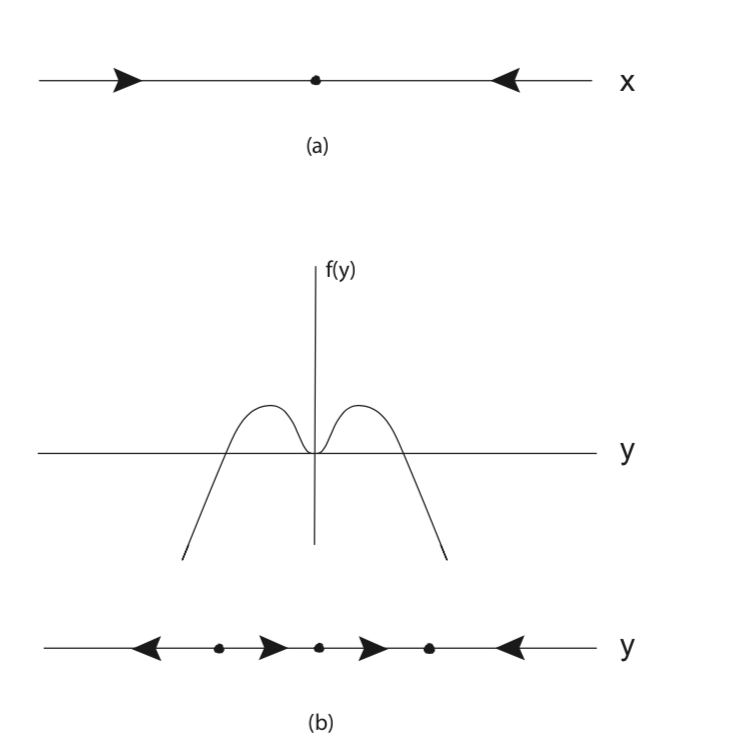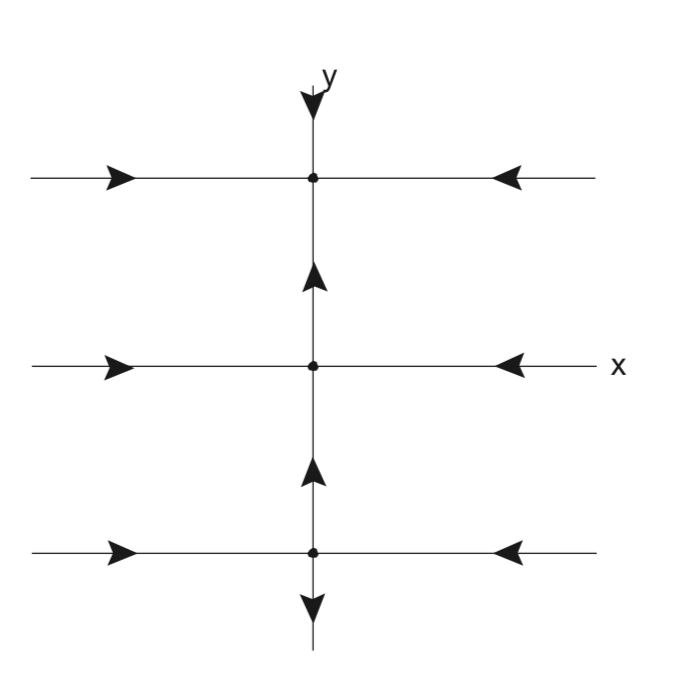3: Behavior Near Trajectories and Invariant Sets - Stability
( \newcommand{\kernel}{\mathrm{null}\,}\)
Consider the general nonautonomous vector field in n dimensions:
and let
Many questions in ODEs concern understanding the behavior of neighboring solutions near a given, chosen solution. We will develop the general framework for considering such questions by transforming Equation
We consider the following (time dependent) transformation of variables:
We wish to express Equation
or
Hence, we have shown that solutions of Equation
The first question we want to ask related to the behavior near
We begin by defining the notion of ''Lyapunov stability'' (or just "stability").
Definition 13 (LYAPUNOV STABILITY)
y = 0 is said to be Lyapunov stable at
If a solution is not Lyapunov stable, then it is said to be unstable.
Definition 14 (UNSTABLE)
If y = 0 is not Lyapunov stable, then it is said to be unstable.
Then we have the notion of asymptotic stability.
Definition 15 (ASYMPTOTIC STABILITY)
y = 0 is said to be asymptotically stable at
- it is Lyapunov stable at
- there exists
We have several comments about these Definitions.
- Roughly speaking, a Lyapunov stable solution means that if you start close to that solution, you stay close–forever. Asymptotic stability not only means that you start close and stay close forever, but that you actually get "closer and closer" to the solution.
- Stability is an infinite time concept.
- If the ODE is autonomous, then the quantity
- The Definitions of stability do not tell us how to prove that a solution is stable (or unstable). We will learn two techniques for analyzing this question–linearization and Lyapunov’s (second) method.
- Why is Lyapunov stability included in the Definition of asymptotic stability? Because it is possible to construct examples where nearby solutions do get closer and closer to the given solution as
"Stability" is a notion that applies to a "neighborhood" of a trajectory. At this point we want to formalize various notions related to distance and neighborhoods in phase space. For simplicity in expressing these ideas we will take as our phase space Rn. Points in this phase space are denoted
The distance between two points in
\[= \sqrt{\sum_{i=1}^{n} \sqrt{(x_{i}-y_{i})^2}. \label{3.7}\]
Distance between points in
We remark that it follows from the Definition that if
We have previously defined the notion of an invariant set. Roughly speaking, invariant sets are comprised of trajectories. We now have the background to discuss the notion of . Recall, that the notion of invariant set was only developed for autonomous vector fields. So we consider an autonomous vector field:
and denote the flow generated by this vector field by
The definition of Lyapunov stability of an invariant set is as follows.
DEFINITION 16 (LYAPUNOV STABILITY OF M)
M is said to be Lyapunov stable if for any neighborhood
Similarly, we have the following definition of asymptotic stability of an invariant set.
DEFINITION 17 (ASYMPTOTIC STABILITY OF M)
M is said to be asymptotically stable if
- it is Lyapunov stable,
- there exists a neighborhood
In the dynamical systems approach to ordinary differential equations some alternative terminology is typically used.
DEFINITION 18 (ATTRACTING SET)
If M is asymptotically stable it is said to be an attracting set.
The significance of attracting sets is that they are the "observable" regions in phase space since they are regions to which trajectories evolve in time. The set of points that evolve towards a specific attracting set is referred to as the basin of attraction for that invariant set.
DEFINITION 19 (BASIN OF ATTRACTION)
Let
Then call B is called the basin of attraction of M.
We now consider an example that allows us to explicitly explore these ideas.
Example
Consider the following autonomous vector field on the plane:
First, it is useful to note that the x and y components of Equation
In Fig. 3.1 we illustrate the flow of the x and y components of Equation
The two dimensional vector field Equation
In this example it is easy to identify three invariant horizontal lines (examples of invariant sets). Since y = 0 implies that


Additional invariant sets for (3.10).
{(x, y)|
{(x, y)|
{(x, y)|
{(x, y)|
{(x, y)|
{(x, y)|
{(x, y)|
{(x, y)|


